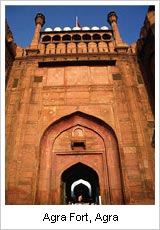Introduction:
Jahangiri Mahal is the most important building of the Akbari
period and the most significant building inside the Agra Fort.
The Jahangir Mahal was the principal zenana palace. A splendid
gateway leads to an interior courtyard surrounded by grand
halls covered with profuse carvings on stone, heavily fashioned
brackets, piers, and crossbeams. The zenana palce was built
for women belonging to the royal household and was mainly
used by the Rajput wives of Akbar.
The Jahangir Mahal in Agra boasts a splendid gateway which
leads to an interior courtyard surrounded by grand halls covered
with profuse carvings on stone, heavily fashioned brackets,
piers, and crossbeams. You can still spot the remains of decorations
in gold and blue done in the prevalent Persian style. The
features of the Jahangir Mahal are mixed in Transoxanian or
Central Asian features such as the verandah on the east front
with its high slender columns with courtyard halls styled
in the broader Gujarat-Malwa-Rajasthan tradition. This tradition
has been passed onto the Mughals by the architecture of Raja
Man Singh of Gwalior in the early 16 th century.
The Jahangir Mahal, Agra is glaring example of a daring approach
in architecture. The brackets which are so typical of the
Gujaratis feature animal and floral motifs which are fabulously
carved. They also register a dominating effect on the few
Islamic features such as the verandah on the eastern front
with exquisitely slender pillars facing the riverfront. Jahangiri
Mahal mixes Transoxanian (Central Asian) features, such as
the verandah on the east front with its high slender columns
(a translation into stone of the timber iwan of vernacular
Transoxanian architecture), with courtyard halls styled in
the broader Gujarat-Malwa-Rajasthan tradition as it had been
passed onto the Mughals by the early 16th-century architecture
of Raja Man Singh of Gwalior. This exotic medley and adventurous
eclecticism suggests a daring approach in architecture. The
typically Gujarati brackets-fabulously carved animal and floral
motifs-register a dominating effect on the few Islamic features
such as the verandah on the eastern front with exquisitely
slender pillars facing the riverfront.
|
|
 |

